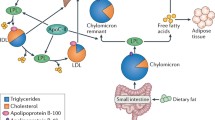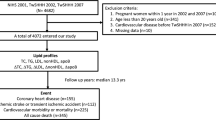Abstract
In the PROCAM study hypertriglyceridaemia was much more common among men (18.6%) than women (4.2%). Prevalence increased with age in women, but remained nearly constant at about 20% in men aged 35 years or more.
In a multiple regression analysis a strong negative correlation between triglycerides and HDL cholesterol was found. A positive relationship was observed with cholesterol, blood glucose, factor VIIc, and PAI-1 in both sexes. Only in men, triglycerides are positively correlated with Apo A-1, body mass index, cigarette smoking, and alcohol consumption. Postmenopausal women showed higher triglyceride levels than premenopausal women. No independent relationships were observed to age, blood pressure, Lp(a), Apo A-II, Apo B, AT-III, protein C, fibrinogen, and oral contraceptives.
A longitudinal analysis of data from 4474 male PROCAM participants aged 40–64 years with a follow-up of 4 years did not identify triglycerides as an independent risk factor, but the data suggest hypertriglyceridaemia is an additional risk factor for CHD, when excessive triglycerides coincide with a high ratio of plasma cholesterol to HDL-cholesterol and with low HDL-cholesterol values.
Similar content being viewed by others
References
AbbotR.D. andCarrolR. (1984): Interpreting multiple logistic regression coefficients in prospective observational studies - Am. J. Epidemiol.119: 830–836.
AbergH.,LithellH.,SelinusI. andHedstrandH. (1985): Serum triglycerides are a risk factor for myocardial infarction but not for angina pectoris. Results from a 10-year follow-up of Uppsala Primary Preventive Study - Atherosclerosis54: 89–97.
AssmannG.,OberwittlerW.,SchulteH., et al. (1980): Prädiktion und Früherkennung der koronaren Herzkrankheit - Internist.21: 446–459.
AssmannG. andSchulteH. (1986): Procam-Studie -Panscientia Verlag, Hedingen Zürich.
AssmannG. andSchulteH. (1988): The Prospective Cardiovascular Munster (PROCAM) study: Prevalence of hyperlipidemia in persons with hypertension and/or diabetes mellitus and the relationship to coronary heart disease - Am. Heart J.116: 1713–1724.
Barrett-ConnorE. andKhawK.T. (1986): Borderline fasting hypertriglyceridemia. Absence of excess risk of all-cause and cardiovascular disease mortality in healthy men without hypercholesterolemia - Prev. Med.16: 1–8.
BenfanteR.J.,ReedD.M.,MacLeanC.J. andYanoK. (1989): Risk factors in middle age that predict early and late onset of coronary heart disease. - J. Clin. Epidemiol.42: 95–104.
BrownD.F.,KinchS.H. andDoyleJ.T. (1965): Serum triglycerides in health and in ischemic heart disease -N. Engl. J. Med.273: 947–952.
CambienF.,JacquesonA.,RichardJ.L., et al. (1986): Is the level of serum triglyceride a significant predictor of coronary death in “normocholesterolemic” subjects? The Paris prospective Study - Am. J. Epidemiol.124: 624–632.
CarlsonL.A. andBottigerL.E. (1985): Risk factors for ischemic heart disease in men and women. Results of the 19-year follow-up of the Stockholm Prospective Study - Acta Med. Scand.218: 207–211.
CastelliW.P. (1986): The triglyceride issue: A view from Framingham - Am. Heart J.112: 432–437.
Consensus Conference (1984): Treatment of Hyper-triglyceridaemia- JAMA251: 1196–1200.
CriquiM.H.,HeissG.,CohnR., et al. (1987): Triglycerides and coronary heart disease mortality. The Lipid Research Clinics Follow-up Study - CVD Dyslipidemiology Newsletter41: 13.
GlynnR.J.,RosnerB. andSilbertJ.E. (1982): Changes in cholesterol and triglyceride as predictors of ischemic heart disease - Circulation66: 724–731.
HeydenS.,HeissG.,HamesC.G. andBartelA.G. (1980): Fasting triglycerides as predictors of total and CHD mortality in Evans county, Georgia - J. Chronic Dis.33: 275–282.
HulleySB.,RosenmanR.H.,BawolR.D., et al. (1980): Epidemiology as a guide to clinical decisions. The association between triglyceride and coronary hearty disease - N. Engl. J. Med.302: 1383–1389.
PelkonenR.,NikkilaE.A.,KoskinenS., et al. (1977): Association of serum lipids and obesity with cardiovascular mortality - Br. Med. J.2: 1185–1187.
PeterssonB.,TrellE. andHoodB. (1984): Premature death and associated risk factors in urban middle-aged men - Am. J. Med.77: 418–426.
PocockS.J.,SharperA.G. andPhillipsA.N. (1989): Concentrations of high density lipoprotein cholesterol, triglyceride and total cholesterol in ischaemic heart disease - Br. Med. J.298: 998–1002.
SalonenJ. andPuskaP., (1983): Relation of serum cholesterol and triglycerides to the risk of acute myocardial infarction, stroke and death in Eastern Finnish male popultion - Int. J. Epidemiol.12: 26–31.
Study Group, European Atherosclerosis Society (1987): Strategies for the Prevention of coronary heart disease: A policy statement of the European Atherosclerosis Society - Eur. Heart. J.8: 77–88.
TibblinG. andCramerK. (1963): Serum lipids during the course of an acute myocardial infarction and one year afterwards - Acta Med. Scand.174: 451–455.
TverdalA.,FossO.P.,LerenP., et al. (1989): Serum triglycerides as an independent risk factor for death from coronary heart disease in middle-aged Norwegian men - Am. J. Epidemiol.129: 458–465.
Author information
Authors and Affiliations
Additional information
Corresponding author
Institut fur Arteriosklerose - forschung an der Universität Munster - Domagkstraße 3 D-4400 Münster - Germany
Rights and permissions
About this article
Cite this article
Assmann, G., Schulte, H. The importance of triglycerides: Results from the prospective cardiovascular Münster (PROCAM) study. Eur J Epidemiol 8 (Suppl 1), 99–103 (1992). https://doi.org/10.1007/BF00145359
Issue Date:
DOI: https://doi.org/10.1007/BF00145359




